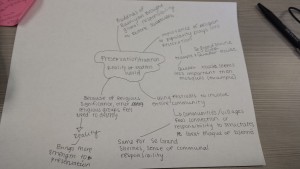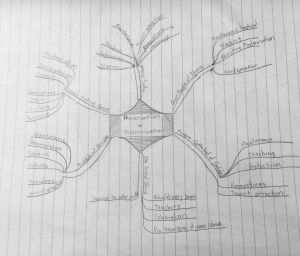Please see attached worksheet with Sacred Structures Chart breakdown.
Other large sacred structures
The Great Mosque of Djenne was built using baked earth bricks called ferey, and sand and earth based mortar. It was then coated with plaster giving it the smooth finished look. The walls are decorated with rodier palm stick bundles called toron. This toron also serves as ready made scaffolding for the restoration done yearly. The foundation of the mosque is lifted to prevent severe damage during flooding. Only small changes have been made to the mosque since 1907 because it is maintained and restored on a regular basis. Though the original structure had much fewer toron. The part that I thought was really cool regarding the the Great Mosque of Djenne was that there is a annual festival held for everyone to participate in the restoration and maintenance. In the days leading up to the festival the plaster is premixed in large pits, and is stirred and mixed by the young boys playing in it. The women bring water to the plaster pits as well as the men. The men climb into the toron and place the plaster on the walls. The members of the Djenne mason guild direct the work and the elders of the community sit and watch for they have already participated in the festival many times. The original mosque presided over one of the most important learning centers in the middle ages, with thousands of students coming to it to study the Qur’an. Also after vogue magazine held a photo shoot there with scantily dressed models, the mosque was closed to non muslims. Though this isn’t exactly a threat, the community saw a group of men hacking at the roof of the mosque which sparked riot and led the men fleeing in fear of being hung. These men were actually part of a restoration project. This just goes to show how respected the mosque is by the community and what they would do in fear of threat to the structure.
Mosque-Cathedral of Cordoba- The roman columns part of this structure came as presents from governors during that time. For some of the decorations inside of the mosque ivory, jasper, porphyry, gold, silver, copper and brass were used. The mosque is also covered in many mosaics and azulejos (similar idea of art work). This mosque is most notable for arcaded hypostyle wall, which is a roof held up by 856 columns. This structure to me is far more exquisite, compared to the other structures discussed in this post, the materials used are much different. I am a little confused on one part of this structure so if anyone can clear it up for me that would be great, I know that the structure has been shared by more then one religion but was it first a muslim mosque and is now Catholic, or has it been switch more then one time? I know that currently it is a Catholic structure, knowing that muslims across spain still lobby to be allowed to pray in the church. In 2010 two muslim men were arrested when during a tour they stopped and started praying, the guards asked them to stop or leave and upon refusing a fight broke out and the two guards were injured. There is a law in place that guarantees the protection of the property by the state.
Ise Grand Shrine- Compared to the two previous structures discussed above these shrines are and were created with extreme simplicity. Though similar to the the Great Mosque of Djenne, a festival going back as far as the 7th century is held every 20 years to destroy and rebuild the main shrines. The new shrines are built using the exact same methods as used on all of the previous shrines, which means no nails. Also the old wood is recycled some times being used for other shrines around Japan. These shrines are extremely important and sacred to Japanese religion, also being an attraction to tourists.
Buddhas of Bamiyan- The main bodies of the buddhas were carved into a stone cliff, the other parts of the bodies were sculpted from stone and stucco mix supported by wood posts. At one time an emperor attempted to use heavy artillery to destroy the structures but failed. Another attempt was made by a persian king also using heavy artillery but also failed at his attempts. An Afghan king succeeded at destroying the face of one of the structures. Though the last and final attempt of destruction was successful. In 2001 the Taliban dynamited and destroyed both of the structures. This was part of cracking down on “un-islamic” parts of Afghan society.
Friends meeting house- also called religious society of friends, created and used by the Quakers. The friends meeting house is a stark contrast to all of the other structures discussed. The Quakers didn’t believe that they needed a specific special place to gather and worship. They believed that “where two or three meet together in my name, I am there among them“. I had to take this directly from wiki because it explains it perfectly. The guidelines to a meeting house were simplicity, equality, community, and peace, without any symbols of public worship. Since this is there belief there wouldn’t really be much importance is restoration. Really no more than one would to there own home because they live in it and need to be able to use it. The traditional model of a friends meeting house had a main meeting room and a separate meeting room used by the women. I think more importance is held for restoration and or preservation of friends meeting houses more for the history and less for the religious importance since the building itself was not important, it was the group of people meeting together to worship. 
4.2 Other Large Sacred Structures
I found though my reading and other research that most of the structures did seem to focus more on preservation. Some would do annual maintenance , celebrations to pass down traditions, or rebuild the entire structure. Along with restricting general citizen or tourist usage or not allowing it at all.
Modernization seems to be updating with modern amenities such as electricity, HVAC and toilets, which some have not done to maintain historical integrity. Most of the modernization that has been done is a way for the structure to be turned into a tourist attraction to obtain funds to aid in preservation of the structures.
- « Previous Page
- 1
- …
- 59
- 60
- 61
- 62
- 63
- …
- 102
- Next Page »
